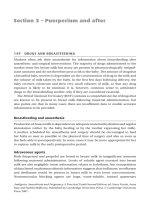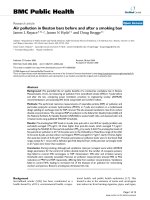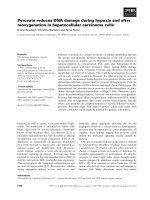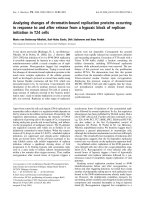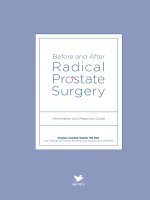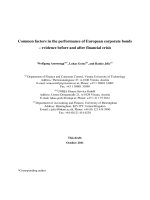PUERPERIUM AND AFTER
Bạn đang xem bản rút gọn của tài liệu. Xem và tải ngay bản đầy đủ của tài liệu tại đây (59.17 KB, 8 trang )
Section 3 – Puerperium and after
149 DRUGS AND BREASTFEEDING
Mothers often ask their anaesthetist for information about breastfeeding after
anaesthetic and surgical interventions. The majority of drugs administered to the
mother enter her breast milk but many are present in pharmacologically insignif-
icant amounts and do not therefore pose a risk to the baby. The amount of drug that
a breastfed baby receives is dependent on the concentration of drug in the milk and
the volume of milk taken by the baby. In the first few days following delivery, the
baby receives colostrum and then very small volumes of milk, so that any drug
exposure is likely to be minimal. It is, however, common sense to administer
drugs to the breastfeeding mother only if they are considered essential.
The British National Formulary (BNF) contains a comprehensive list of drugs that
are known to be present in breast milk following maternal administration, but
also points out that in many cases there are insufficient data to enable accurate
information to be provided.
Breastfeeding and anaesthesia
Production of breast milk is dependent on adequate maternal hydration and regular
stimulation (either by the baby feeding or by the mother expressing her milk).
A mother scheduled for anaesthesia and surgery should be encouraged to feed
her baby as near as possible to the planned time of surgery and also as soon as
she feels able to postoperatively. In some cases it may be more appropriate for her
to express milk in the early postoperative period.
Intravenous agents
Both thiopental and propofol are found in breast milk in insignificant amounts
following maternal administration. Levels of volatile agent excreted into breast
milk are also negligible (most information relates to halothane, but extrapolation
of data based on pharmacokinetic information suggests that isoflurane, sevoflurane
and desflurane would be present in breast milk in even lower concentrations).
Neuromuscular blocking agents are large, water-soluble, ionised quaternary
Analgesia, Anaesthesia and Pregnancy: A Practical Guide Second Edition, ed. Steve Yentis, Anne
May and Surbhi Malhotra. Published by Cambridge University Press. ß Cambridge University
Press 2007.
ammonium compounds and therefore are not excreted into breast milk in any
measurable quantity.
Analgesics
Transfer of non-steroidal anti-inflammatory drugs and opioids into breast milk
has been extensively studied, and neither type of analgesic is present in clinically
important quantities. Therapeutic doses of morphine and diamorphine given
for postoperative analgesia (either following Caesarean section or other surgical
intervention) can be given to the mother as required. The BNF states that breast-
feeding is not recommended for mothers who are addicted to opioids, although
this may be controversial since the American Academy of Pediatrics considers that
up to 20 mg methadone daily is compatible with breastfeeding.
Antiemetics
All the commonly used antiemetics carry a manufacturers ‘use with caution’ or ‘use
only if essential’ warning.
Benzodiazepines
Prolonged administration of benzodiazepines should be avoided. Diazepam is
found in clinically significant quantities in breast milk and may cause hypotonia
and impaired suckling in the baby. However, use of a single dose of temazepam or
lorazepam as a premedicant drug is not contraindicated. Similarly, use of midazo-
lam for intravenous sedation or during general anaesthesia is considered safe.
Other drugs
Anticoagulants
Warfarin is now considered to be safe in breastfeeding mothers; there are currently
insufficient data about low molecular weight heparins, which the manufacturers
therefore advise should be avoided.
Antidepressants
The most recent Report on Confidential Enquiries into Maternal Deaths/Maternal
and Child Health has highlighted the risk of postnatal depression and its potential
to lead to postnatal psychosis and suicide. There are numerous case reports
offering conflicting advice about the use of psychotropic drugs in lactating
women. The tricyclic antidepressants amitriptyline, nortriptyline and desipramine
are all excreted into breast milk, with the baby being exposed to approximately 1%
of the maternal dose. This poses a theoretical risk for the infant, but there are
no case reports of adverse effects, and the balance of risks is generally believed
to favour continuing treatment of the mother and allowing breastfeeding.
Information about the selective serotonin reuptake inhibitors (SSRIs) in lactation
is limited. The drugs are excreted into breast milk, but there are no controlled
338 Section 3 – Puerperium and after
studies investigating effects on the infant. The manufacturer’s data sheet states that
fluoxetine should not be given to nursing mothers.
Anticonvulsants
Epileptic mothers can be allowed to breastfeed; although the commonly used
anticonvulsants are excreted into breast milk, there have not been any reported
adverse effects in babies.
Antihypertensives
It is common for pre-eclamptic women to receive b-blocking drugs for several
weeks following delivery. Atenolol is excreted in breast milk in measurable
amounts, but there is no evidence that this is harmful to the infant.
Key points
• Most drugs are excreted into breast milk; information about the effect on the neonate
is scarce.
• Commonly used anaesthetic and analgesic drugs can be safely used in breastfeeding
mothers.
FURTHER READING
American Academy of Pediatrics Committee on Drugs. The transfer of drugs and other
chemicals into human milk. Pediatrics 2001; 108: 776–89.
Hale TW. Maternal medications during breast-feeding. Clin Obstet Gynecol 2004; 47: 696–711.
150 FOLLOW-UP
Follow-up of mothers after obstetric analgesia and anaesthesia is important for
the individual anaesthetist, the hospital and obstetric anaesthesia as a whole.
In an ideal world all anaesthetists would aim to follow up their own patients. This
ideal is often not practical; therefore follow-up has to become part of the routine of
an obstetric anaesthetic service. At national and international levels, data collection
would enable anaesthetists to assess risk and monitor standards of care. At present
there are very few data available at national or international level, and this is an
area that comes more closely under the remit of audit.
Problems/special considerations
Follow-up of women who have had analgesia or anaesthesia administered by the
anaesthetist should ideally be carried out within 24 hours. However, it may be dif-
ficult to see all women before they are discharged from hospital. This early
150 Follow-up 339
discharge to the community means that anaesthetists must rely on midwifery,
obstetric and general practitioner colleagues to refer back any problems. Areas
that anaesthetists might wish to follow up can be divided into:
• Anaesthetic interventions perceived to be uncomplicated
• Anaesthetic interventions where there was a problem.
Follow-up of the first group is important to ensure that women are satisfied with
their treatment and, if not, why not. The follow-up interview gives the woman a
chance to voice her opinion of the treatment she received. The anaesthetist should
be responsive to criticisms of the service as a whole, since many women make their
comments in order to help improve the service to others.
Suggested list of questions that may be asked at follow-up:
• Relating to analgesia in labour: Were you satisfied with the pain relief you
received for the first and second stages of your labour? Were you able to mobilise
during labour where appropriate? Has your sensation returned to normal? Have
you a headache? Have you any comments about the care that you received?
• Relating to regional anaesthesia: Were you satisfied with the anaesthesia that
you received? Did you feel any discomfort or pain at any time during the
Caesarean section? Have you had good postoperative pain relief? Are you up
and about? Are you able to pass urine? Has your sensation returned to normal?
Have you a headache? Have you any comments about the treatment that you
received?
• Relating to general anaesthesia: Did you have a good sleep? Do you remember
going to sleep? Do you remember waking up? Do you remember dreaming
or waking up during the operation? Do you have a sore throat, sore muscles
or headache? Were you in pain when you woke up? Has the postoperative
pain relief been adequate (at rest and on movement)? Have you had nausea or
vomiting? Have you any comments about your treatment?
The most common problems associated with an anaesthetic intervention are:
• Difficulty in siting a regional analgesic
• Accidental dural puncture
• Paraesthesia during insertion of a spinal or epidural, and/or neurological
symptoms afterwards
• Poor analgesia in labour (especially in the second stage if the epidural was
inadequately topped up)
• Pain during Caesarean section or operative delivery.
Patients with the above problems should always be followed up, ideally by a
consultant obstetric anaesthetist. Continuity of care is important for these patients,
and early involvement of other specialists, when appropriate, should occur at an
early stage. For example, neurological consultation should be sought when there is
any doubt as to the cause of a headache or neurological deficit. Early involvement
of a clinical psychologist with a special interest in post-traumatic stress disorder
following childbirth (if available) is often useful when there has been a painful
experience during delivery.
340 Section 3 – Puerperium and after
Communication with the women, their partners and the midwifery and obstetric
staff is essential to ensure that any problems, however small, are dealt with quickly
and comprehensively. All women who have had a problem should have the oppor-
tunity to see the consultant obstetric anaesthetist after discharge from hospital.
A follow-up visit at around 6–8 weeks post-delivery is useful for both the women
and the obstetric anaesthetist. This consultation allows the lines of communication
to remain open and offers the opportunity for a frank and open dialogue about
any problems.
Key points
• Follow-up is important in both straightforward and complicated cases.
• Follow-up does not end when the woman leaves hospital.
• Consultant anaesthetic involvement is important.
• Communication is vital between all the professional groups involved.
FURTHER READING
Peach M, Godkin R, Webster S. Complications of obstetric epidural analgesia and anaesthesia:
a prospective analysis of 10 995 cases. Int J Obstet Anesth 1998; 7: 5–11.
151 MATERNAL SATISFACTION
Maternal satisfaction has become a major outcome measure, mentioned in several
important documents and strategies concerned with childbirth. This means that
providers of health care must pay attention to mothers’ expression of satisfaction
with their care during and after pregnancy. Anaesthetists have an important role to
play in maternal satisfaction, since for many women aspects of their analgesia and
anaesthesia can have an enormous effect on how they view their overall experience,
in some cases irrespective of what happened in other areas of their care. Conversely,
mothers’ rating of their satisfaction with analgesia or anaesthesia in general, and
different techniques in particular, may be affected by several factors unrelated
to the anaesthetic itself. Despite this, studies comparing different techniques
often quote measures of global satisfaction as evidence that one technique is
superior to another. Similarly, obstetric anaesthetists are encouraged to assess
and audit maternal satisfaction with the obstetric anaesthetic service as a marker
of quality of performance.
Problems/special considerations
Apart from the confounding effects of various unrelated factors described
above, another difficulty relates to the measuring tool used to assess satisfaction.
151 Maternal satisfaction 341

